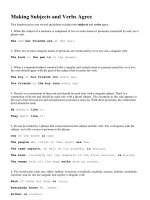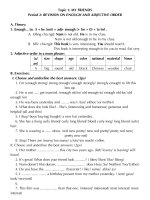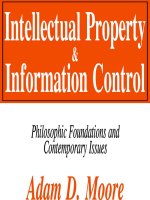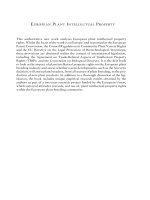Traditional Knowledge and Intellectual Property doc
Bạn đang xem bản rút gọn của tài liệu. Xem và tải ngay bản đầy đủ của tài liệu tại đây (2.36 MB, 82 trang )
A Handbook on Issues and Options for
Traditional Knowledge Holders in
Protecting their Intellectual Property and
Maintaining Biological Diversity
Stephen A. Hansen and Justin W. VanFleet
TITLE: Traditional Knowledge and Intellectual Property: A Handbook on Issues and
Options for Traditional Knowledge Holders in Protecting their Intellectual Property
and Maintaining Biological Diversity
PERSONAL AUTHORS: Hansen, Stephen and VanFleet, Justin
CORPORATE AUTHOR: American Association for the Advancement of Science (AAAS)
Science and Human Rights Program
PLACE OF PUBLICATION: Washington, DC
PUBLISHER: AAAS
ADDRESS: 1200 New York Avenue, NW Washington, DC 20005 United States of
Ame rica
TELECOMMUNICATIONS: tel: 1.202.326.6600; fax: 1.202.289.4950; e-mail:
DATE OF PUBLICATION: July 2003
PAGES: 85
ISBN: 0-87168-690-2
LANGUAGE: ENG
STATISTICAL INFORMATION: N
INDEX: Human Rights / Intellectual Property Rights / Traditional Knowledge
FREE TEXT: This handbook is designed to make intellectual property protection is-
sues and options more understandable to traditional knowledge holders and human
rights organizations and legal professionals working with local and indigenous com-
munities.
This report is a product of the AAAS Science and Human Rights Program. The AAAS
Science and Human Rights Program operated under the oversight of the AAAS Com-
mittee on Scientific Freedom and Responsibility (CSFR). The CSFR, in accordance
with its mandate and Association policy, supports publication of this report as a sc i-
entific contribution to human rights. The interpretations and conclusions are those of
the author and do not purport to represent the views of the AAAS Board, the AAAS
Council, the CSFR, or the members of the Association.
ISBN 0-87168-690-2
Copyright © 2003 by the
American Association for the Advancement of Science
1200 New York Avenue, NW
Washington, DC 20005
This material may be duplicated or reproduced in any manner for noncommercial use
by non-profit organizations, academic institutions, or local and indigenous communi-
ties. Please acknowledge authors and source: AAAS Science and Human Rights Pro-
gram. For copies of this manual, consult the Internet:
/>Printed in the United States of America.
iii
ACKNOWLEDGEMENTS
The authors would like to thank the following people and organizations for their sup-
port and assistance throughout the creation of this handbook:
The Secretariat of the World Intellectual Property Organization’s Intergovernmental
Committee on Genetic Resources, Traditional Knowledge and Folklore;
Participants from the AAAS Roundtable on Traditional Knowledge at the Fifth Session
of the WIPO IGC on Genetic Resources, Traditional Knowledge and Folklore, Decem-
ber 14, 2002;
Rosemary Coombe, Tier One Canada Research Chair in Law, Communication and
Cultural Studies at York University in Toronto;
Michael Gollin, Venable, LLP, for assistance with legal issues and questions;
Merida Roets, president of ScientificRoets (South Africa) and former AAAS Science
Radio Fellow;
Matthew Zimmerman, Computer Specialist at the AAAS Science and Human Rights
Program;
This publication was made possible in part from grants provided by the Center for
the Public Domain and the Richard and Rhoda Goldman Fund.
Handbook Photo Credit:
H. David Thurston
Cartoon Credit (front cover):
Used with Permission. © Centre for Science and Environment –
v
Table of Contents
Foreword
Part I – Introduction 1
What is Traditional Knowledge? 3
What Are Intellectual Property Rights? 4
Why Traditional Knowledge Holders Should be Concerned 4
Part II – Possible Intellectual Property Protection Options for Traditional
Knowledge Holders 7
Patents
Petty Patent Models
Plant Patents
Plant Variety Certificates
Traditional Knowledge Registries
Trade Secrets
Trademarks
Geographical Indicators
Prior Art and Defensive Disclosure
Prior Informed Consent
Sui Generis Protection Systems
Access and Benefit-Sharing
Contracts – the Basics
Protected/Conservation Areas
Documenting Knowledge 35
Suggestions for Documenting Traditional Knowledge
Part III – Exercises: Identifying Traditional Knowedge 39
Exercise One – Locating and Identifying Traditional Knowledge 41
Exercise Two – Identifying Who Holds the Knowledge 44
Exercise Three – Identifying Intellectual Property Options 47
Example
Worksheets A, B, and C
Part IV– Implementing an Intellectual Property Strategy 55
Following through with an IP Option 57
Exercise Four – Follow through with an IP Option 59
vi
Boxed Asides
International Human Rights Instruments Addressing Intellectual Property
The Public Domain, Prior Art, and Defensive Disclosure
A Sui Generis System in Costa Rica
Issues Surrounding IPRS and Traditional Knowledge
Case Illustration One – Lessons from Maca in the United States
Case Illustration Two – Lessons from Ayahuasca
Case Illustration Three – Registries in India
Case Illustration Four – An American Secret that Kept Paying Royalties
Case Illustration Five - Could the Yellow Bean Dilemma have been Avoided
with a Certification Mark?
Case Illustration Six – Basmati Rice as a Geographical Indicator
Case Illustration Seven – Trade Secret for Benefit Sharing in Ecuador
Case Illustration Eight – The Kraho Indians of Brazil: Misrepresentation in
Contractual Agreements
Obtaining Professional IP Counsel
Suggestions When Forming an Indigenous IP Committee
Figures
Figure 1. Where is TK Located?
Figure 2. Basic Contract Elements and Options
Figure 3. Matrix of Management Objectives and IUCN Protected
Area Management Categories
Annexes
Annex 1. Patent Cooperation Treaty (PCT) Members
Annex 2. Member States to the Convention on Biological Diversity
Annex 3. Member States to the Agreement on Trade Related Aspects of In-
tellectual Property (TRIPs)
Annex 4. Member States to the Convention for the Protection of New Plant
Varieties (UPOV)
vii
International Human Rights Instruments
Addressing Intellectual Property
Universal Declaration of Human Rights (UDHR) (1948)
Article 27:
1. Everyone has the right freely to participate in the cultural life of the
community, to enjoy the arts and to share in scientific advancement and
its benefits.
2. Everyone has the right to the protection of the moral and material in-
terests resulting from any scientific, literary or artistic production of
which he is the author.
International Covenant on Economic, Social and Cultural Rights
(ICESCR)
Article 15:
1. The States Parties to the present Covenant recognize the right of
everyone:
(a) To take part in cultural life;
(b) To enjoy the benefits of scientific progress and its applic a-
tions;
(c) To benefit from the protection of the moral and material inter-
ests resulting from any scientific, literary or artistic production of
which he is the author.
Convention on Biological Diversity (CBD)
Article 8(j):
Subject to its national legislation, respect, preserve and maintain knowl-
edge, innovations and practices of indigenous and local communities em-
bodying traditional lifestyles relevant for the conservation and sustain-
able use of biological diversity and promote their wider application with
the approval and involvement of the holders of such knowledge, innova-
tions and practices and encourage the equitable sharing of the benefits
arising from the utilization of such knowledge, innovations and practices;
International Labor Organization Convention No. 169
Article 15 (1):
The rights of the peoples concerned to the natural resources pertaining
to their lands shall be specially safeguarded. These rights include the
right of these peoples to participate in the use, management and conser-
vation of these resources.
Draft Declaration on Indigenous Rights
Article 29:
Indigenous peoples are entitled to the recognition of the full ownership,
control and protection of their cultural and intellectual property.
They have the right to special measures to control, develop and protect
their sciences, technologies and cultural manifestations, including human
and other genetic resources, seeds, medicines, knowledge of the proper-
ties of fauna and flora, oral traditions, literatures, designs and visual and
performing arts.
Foreword
ince the adoption of the Universal Declaration of Human Rights (UDHR) in
1948, intellectual property (IP) has been considered a fundamental human
right for all peoples. Article 27 of the Declaration states that everyone has
the right “to the protection of the moral and material interests resulting from any
scientific, literary or artistic production of which he is the author.” Since 1948, many
international human rights instruments and documents have reinforced the impor-
tance of IP as a human right.
This handbook represents a step forward in the realization of Article 27 of the UDHR
as it attempts to explain the implications and possible solutions to human rights is-
sues surrounding IP for traditional knowledge holders. This handbook is designed to
make intellectual property protection issues and options more understandable to tra-
ditional knowledge holders and human rights organizations and legal professionals
working with local and indigenous communities. This resource will help traditional
knowledge holders identify potentially applicable protection mechanisms in the cur-
rent intellectual property rights (IPRs) regime.
In addition to introducing basic intellectual property concepts, this handbook con-
tains a series of exercises to help the reader identify traditional knowledge, classify
that knowledge, and think about that knowledge in terms of the goals and interests
of the entire community. By working through the exercises in this handbook, the
reader will be presented with the appropriate intellectual property option or options
that may be employed to protect the traditional knowledge of his or her community.
Complementing each option are text boxes listing the advantages and disadvantages
of each option, as well as the necessary criteria to follow through with that option.
Case illustrations are used to facilitate a better understanding of each option or is-
sue.
The field of intellectual property rights is rapidly changing and laws vary from coun-
try to country. This handbook attempts to provide an accurate summary of general
intellectual property concepts and options. All options are subject to national laws
and legislation. Therefore,
before pursuing any option, it
is important to check with local
legislation. Additionally, any
intellectual property option
mentioned in this handbook
should not be pursued without
consulting appropriate legal
advisors. This handbook
should not be used to advise a
community on a specific action
to take regarding a specific
case, but instead used as a
tool for forming a general IP
strategy to protect and sustain
a community’s knowledge and
biological diversity.
S
Part I
INTRODUCTION
3
Traditional Knowledge and Intellectual Property Rights
What is Traditional Knowledge?
Traditional knowledge (TK) is the information that
people in a given community, based on experience
and adaptation to a local culture and environment,
have developed over time, and continue to de-
velop. This knowledge is used to sustain the com-
munity and its culture and to maintain the genetic
resources necessary for the continued survival of
the community.
Traditional knowledge includes mental inventories of local biological resources, ani-
mal breeds, and local plant, crop and tree species. It may include such information
as trees and plants that grow well together, and indicator plants, such as plants that
show the soil salinity or that are known to flower at the beginning of the rains. It
includes practices and technologies, such as seed treatment and storage methods
and tools used for planting and harvesting. TK also encompasses belief systems that
play a fundamental role in a people's livelihood, maintaining their health, and pro-
tecting and replenishing the environment. TK
is dynamic in nature and may include experi-
mentation in the integration of new plant or
tree species into existing farming systems or a
traditional healer's tests of new plant medi-
cines.
The term “traditional” used in describing this
knowledge does not imply that this knowledge
is old or untechnical in nature, but “tradition-
based.” It is “traditional” because it is created
in a manner that reflects the traditions of the
communities, therefore not relating to the
nature of the knowledge itself, but to the way
in which that knowledge is created, preserved
and disseminated.
1
Traditional knowledge is collective in nature
and is often considered the property of the
entire community, and not belonging to any
single individual within the community. It is transmitted through specific cultural
and traditional information exchange mechanisms, for example, maintained and
transmitted orally through elders or specialists (breeders, healers, etc.), and often to
only a select few people within a community.
Examples of Traditional
Knowledge
• The use of plao-noi in Thai-
land for the treatment of ul-
cers
• The use of the hoodia cactus
by Kung Bushmen in Africa to
stave off hunger
• The use of turmeric in India
for wound-healing
• The use of ayahuasca in the
Amazon basin for sacred re-
ligious and healing purposes
• The use of j’oublie in Came r-
oon and Gabon as a sweet-
ener
Genetic resources –
genetic or biological matter of
actual or potential value
4
What are Intellectual Property Rights?
Intellectual property rights (IPRs) are the
legal protections given to persons over their
creative endeavors and usually give the
creator an exclusive right over the use of
his/her creation or discovery for a certain
period of time.
2
Intellectual property pro-
tections may include patents, copyrights,
trademarks, and trade secrets. Intellectual
property is codified at an international level
through a series of legally binding treaties.
Why Traditional Knowledge Holders Should be Concerned About Intellectual
Property Rights
The knowledge of and uses of specific plants for medicinal purposes (often referred
to as “traditional medicine”) is an important component of TK. Once, traditional
medicines were a major source of materials and information for the development of
new drugs. In the 20th century, however, new sources for pharmaceuticals led to a
decline in the importance of ethnobotany in drug discovery programs. However, new
discoveries of potentially potent anti-cancer agents in plants (such as turmeric and
taxol), as well as a rapidly growing herbal remedies market, has revived industry
interest in traditional medicinal knowledge and practices. As interest in traditional
medicine is rekindled, indigenous knowledge of the cultivation and application of ge-
netic resources is becoming exploited at an alarming rate. World sales of herbal
medicine alone were estimated at US$30 billion in the year 2000.
3
Intellectual property rights should guarantee
both an individual’s and a group’s right to protect
and benefit from its own cultural discoveries,
creations, and products. But Western intellectual
property regimes have focused on protecting and
promoting the economic exploitation of inven-
tions with the rationale that this promotes inno-
vation and research. Western intellectual pro p-
erty law, which is rapidly assuming global ac-
ceptance, often unintentionally facilitates and
reinforces a process of economic exploitation and
cultural erosion. It is based on notions of individ-
ual property ownership, a concept that is often
alien and can be detrimental to many local and
indigenous communities. An important purpose
of recognizing private proprietary rights is to en-
able individuals to benefit from the products of
their intellect by rewarding creativity and en-
couraging further innovation and invention. But in many indigenous world-views, any
such property rights, if they are recognized at all, should be extended to the entire
community. They are a means of maintaining and developing group identity as well
as group survival, rather than promoting or encouraging individual economic gain.
treaties –
International treaties are important
for traditional knowledge as they set
standards and guidelines for busi-
ness, trade, intellectual property,
human rights, access and benefit-
sharing, conservation, and manage-
ment of biological resources. All of
these topics impact traditional
knowledge.
5
Problems experienced by indigenous peoples in trying to protect their traditional
knowledge under intellectual property laws stem mainly from the failure of traditional
knowledge to satisfy requirements for
intellectual protections. Alternatively,
where intellectual property protection
could potentially apply to such knowl-
edge, the prohibitive costs of registering
and defending a patent or other intellec-
tual property right may curtail effective
protection. There has been a clear bias in
the operation of these laws in favor of
the creative efforts of corporations, for
example, pharmaceutical and other in-
dustries in industrialized nations. Within
the context of scientific progress, modern
intellectual property laws have allowed
these industries to monopolize the benefits derived from their use of indigenous
knowledge with disregard for the moral rights and material (financial) interests of
indigenous peoples themselves.
Many incompatibilities between TK and IPRs have begun to surface with the rapid
global acceptance of Western concepts and standards for intellectual property.
These incompatibilities appear when ownership of TK is inappropriately claimed or TK
is used by individuals or corporations that belongs to local communities, primarily in
developing countries. The term “biopiracy” is often used to describe the misappro-
priation of knowledge and/or biological materials from traditional communities.
With today’s rapidly globalizing IPR regime, situations of biopiracy are becoming in-
creasingly evident. Until very recently, an American citizen owned a patent on the
well known and commonly used Amazonian plant ayahuasca. Traditional Andean
uses of maca (Lepidium meyenii) for increased fertility and the Indian use of neem
as a pesticide have been patented in name of profit for Western companies. The spe-
cifics of these examples are complicated and tec h-
nical, but it is not an understatement to suggest
that many more discrepancies will develop between
traditional knowledge and the IPR regime nega-
tively affecting indigenous communities across all
continents. A major concern is that Western cor-
porations will continue to adapt, incorporate, build
upon, or directly claim indigenous knowledge with-
out acknowledgement or compensation for the
communities that developed the knowledge.
However, there is good news. Intellectual property rights do not have to work
against the needs and interests of traditional knowledge holders. In fact, intellectual
property rights can actually benefit traditional knowledge holders by promoting both
their material and moral interests. The key to realizing these benefits is in under-
standing how the intellectual property rights system works and the place that tradi-
tional knowledge can have in the system.
biopiracy–
the misappropriation of
knowledge and/or biological
material from traditional
communities
moral rights –
have historically been associated with
written works and copyright. In the
context of TK, moral rights may be de-
fined as the rights of the knowledge
holders to be given proper acknow-
ledgement of their TK, not to have it
modified without permission, and not
to have it used in a manner that dis-
credits TK holders.
Part II
POSSIBLE INTELLECTUAL PROPERTY
PROTECTION OPTIONS FOR TRADITIONAL
KNOWLEDGE HOLDERS









